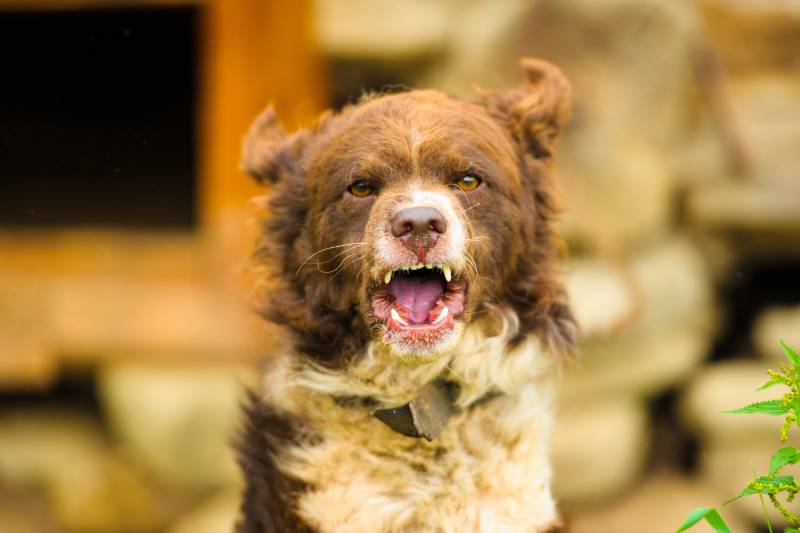One of the most common problems faced by dog owners is aggression in dogs. Dealing with your dog’s behavioral issues can be a hassle without being equipped with the right knowledge and strategies to follow. Contrary to popular belief, not all dogs possess aggressive behavior due to their breed. There are a number of reasons that cause sudden outbursts in dogs. This blog will discuss what they are and how can you prevent them.
Causes for Aggression
Dogs are inherently protective and being territorial is essential to their survival as well. While these two are the most common causes of their aggressive behavior, it’s not the only one. It is crucial to familiarize yourself with canine behavior to better understand your dog’s outbursts. There are many other factors that may trigger a certain stimulus in your dog. Some of these aggressions are:
- Fear-Aggression: It is very common for canines to switch to a fight or flight mode when faced with a fearful or nervous situation, as it’s the only way for them to cope with such situations. This may also be due to past or present trauma. You’ll notice signs of excessive barking, growling, nipping, and later lunging as a response. If a bite takes place, these are typically low in severity, as the dog does not have the confidence to stay in the fight. These are nip-and-run scenarios that take place when you least expect them.
- Food or Toy Aggression: You might’ve noticed that your dog tends to get aggressive when you take their favorite toy or do not give them treats when supposed to. Often, they get aggressive when you are near their food bowl, or you attempt to pick it up. We should never dismiss this aggression as normal; it is NOT normal for a dog to assault you due to food or toy aggression.
- Pain Aggression: Sometimes, the only way for a dog to communicate its pain and suffering is through aggressive behavior. When an owner fails to recognize the source that is causing pain, a dog resorts to growling and nipping as a result of pain and frustration. Veterinary practices deal with pain aggression and fear aggression the most; for obvious reasons.
- Leash-Reaction: Newly adopted dogs or puppies get aggressive when you restrain them with a leash and collar. Frustration drives this condition. Leash reaction is a huge hassle that needs to be prioritized.
- Protective and Territorial Aggression: Mother Dogs tend to get possessive and aggressive towards their pups. If you have two or more dogs, one of them will assume the role of the alpha leader, and therefore will have the capability to be protective of the pack. It is a natural response to protect the pack, however, it also needs to be curbed as it can be dangerous.
Signs of Aggression
How can you tell whether a dog is aggressive or not? They show certain physical behaviors (body language) that we should not ignore. The behavioral experts at K9 University provide behavioral training sessions on how to better read canine body language, and how to curb your dog’s unwanted negative tendencies. Engage these experts if you recognize the following signs:
- Growling and excessive barking at dogs or people.
- Laid back ears; pinned ears.
- Showing the whites of their eyes; whale-eye.
- Not blinking normally.
- Excessive tongue flicking.
- Stiff body; frozen.
- Raised hackles.
- Snapping or biting.
Preventative Measures
When faced with an aggressive episode from your dog, the best action you can take is to remain calm. You don’t want to risk yourself or others by making sudden movements that will trigger the dog’s behavior even further. The best way to prevent future outbursts is to seek an animal behaviorist who understands canines. Enroll in behavioral curbing classes and start the curbing process as soon as possible. These behaviors will indeed get worse if left untreated.
Here are some basic measures you can take before an aggressive episode starts and the real question is, what can you do?
- Start Training Early: Start training your dog when they are a puppy and impressionable. Teach them the social rules you live by. Take them to training sessions and socialize them with other dogs and people.
- Don’t Punish: Punishing or hitting the dog for their behavior may backfire and cause even more aggression. Besides, they don’t understand it for what it is, rather, that you’re punishing their last action, which could be sitting, looking at you, or walking away. The aggression that took place three actions ago is no longer an active memory.
- Seek Permission before Petting: Some dogs don’t like to be petted. Ask the owner before you reach to pet one. Even then, pay attention to the signs mentioned earlier.
- Contact a Professional: It’s recommended that you consult a professional regarding your dog’s behavioral issues. You will always find comprehensive guidance at K9 University through our patented behavioral sciences routines.
Need Assistance with a dog bite incident?
K9 University’s critical behavior education not only prevents dog bites but also curbs their aggressive behavior if already present. By incorporating patented behavioral sciences, K9 University’s training programs prove to be effective and adaptable in real-world situations. Contact us to book a training session and begin your dog’s behavior change journey at the earliest!



